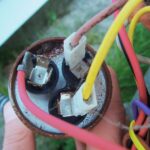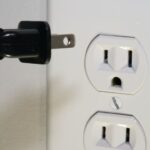Most household circuits are wired parallel, powering light fixtures, outlets, and appliances. That makes sense because, with a parallel circuit, the current divides into two or more paths before coming back together to complete the entire circuit. But, the question is, can you still wire outlets in a series circuit?
To wire outlets in a series circuit, follow the steps below:
- Turn off the power
- Look for the studs and string the cables through the holes
- Run a power cable through the first receptacle and anchor the box to the drywall
- Then, use wire strippers to expose the ends and connect the wires to the terminals
- Finally, screw the receptacle into place and turn the power on
Read on to learn more about how to wire electrical outlets in a series circuit and the safety concerns.
Wiring Outlets in Series

Not Commonly Used in Home Wiring
Series circuits are not usually used in home wiring, but some still use them with Christmas light strings and outdoor lanterns.
Steps
To wire outlets in a series circuit, you will first need to turn off the power, look for the studs and string the cables through the holes.
Once done, run a power cable through the first receptacle and anchor the box to the drywall. Then, use wire strippers to expose the ends and attach the wires to the terminals. Finally, screw the receptacle into place and turn the power on.
Note That the Electrical Outlets Have Four Terminals
Remember that electrical outlets have four terminals, two of which are brass and the other two are silver. In the mix is a solitary green terminal as well. Plus, capacitors are connected when you wire them in series.
Even though the wiring colors of AC capacitors are not the same, the charging current (iC) flowing through them is the same since there is only one path to take.
Benefits of Using a Series Circuit
One of the benefits of using a series circuit is that you can wire many outlets in one room. The current travels along a single path in a closed circuit. Each device is connected in a straight line through the circuit loop. So, if one device malfunctions or is disconnected, the circuit as a whole is disrupted.
Step-by-step Guide on How to Wire Electrical Outlets in a Series
Here is a step-by-step guide on how to wire electrical outlets in a series circuit:
1. Turn off the Power
This is common sense, but do not forget to turn off the power source before you start any electrical project. Put up an electrical box for each additional outlet you want. We recommend that you use a renovation box for this to avoid removing any wall coverings.
2. Look for the Studs
Use a stud finder to locate the studs, and then tuck the box in between two of them. Draw the box’s outline on the drywall with a pencil, and then use a drywall saw to cut out the hole.
3. String the Cables Through the Holes
Fill each of the holes with the cables you need to wire the outlet. To avoid removing the drywall, you can feed wires through 3/4-inch holes in the top or bottom plates of the wall and then run them laterally into the attic or crawl space.
The process will vary depending on how you connect each receptacle, though.
4. Run a Power Cable to the Outlet
Each circuit should have a series of outlets, and you should run the power wire to the first one in the series. Connect a second cable from that outlet to the next outlet in the series, then a third cable from the next outlet to the following one, and so on.
5. Anchor the Box to the Drywall
Pull out roughly 6 inches of cable slack and feed the cables for each outlet through the back of the previous work box. Remember that you should do this before you push it into the hole.
Then, tighten the screws in the front with a Phillips screwdriver to secure it to the drywall.
6. Use Wire Strippers to Expose the Ends
Remove about 6 inches of the sheath from each cable and leave each insulated wire’s ends exposed by about half an inch using wire strippers. Determine which wires are the incoming, live ones and which ones are sending power to another outlet.
7. Join the Terminals and the Wires
Use pliers to wrap the incoming wires around the receptacle’s top pair of terminals. Make sure to connect the white wire to the silver terminal and the black wire to the brass terminal. Next, tighten the terminal screws with a screwdriver.
Now, you should connect the incoming wires in the same manner to the second set of terminals. Trap the ground wires around the green ground terminal by twisting them together.
8. Install the Receptacle in Place
Once you are done wiring it, push each receptacle into the box and secure it with a screw. You can use a flathead screwdriver to attach a cover plate.
9. Turn the Power On
Attach the power line to the power source, which may be a circuit breaker in the panel or a device on a different circuit, and you are good to go!
Should Outlets Be Wired in Series or Parallel?
Is It Safe to Wire Electrical Outlets in a Series Circuit?

Risk of Overloading the Circuit Breaker
It is yes and no, as many factors play into this. For instance, when you wire outlets in a series circuit, you risk overloading the circuit breaker, resulting in electrical mishaps.
In other words, the voltage of a single circuit may sometimes not be enough for an outlet to consume.
Even more so, if you plug many outlets in, the low voltage will be delivered to the final outlet in the series. This is not good compared to parallel circuits, which deliver equal voltage to each outlet.
Moreover, if the circuit breaker blows because of an overload, this will have a devastating impact on your outlets.
When using a series circuit, it is common for one defective outlet to affect more outlets. This is why series circuits violate some of the electrical codes in many states.
Carefully Choose the Devices You Want to Connect in a Series Circuit
You should carefully choose the devices you want to connect in a series circuit. If all of your devices are low-power, you will be just fine. It will also be a good idea to observe how much electricity each appliance consumes.
An average phone charger uses 5 to 20 watts of power. This, of course, will increase for laptops, which typically use between 100 and 300 watts.
Use GFCI Outlets
Wiring in series circuits is safe if the consumption rate does not exceed the circuit’s capacity. We recommend that you use GFCI outlets in conjunction with other outlets to provide precise information about your outlet.
Remember that you should always abide by the state-set electrical code where you live, as each state has its own set of codes.
How to Reduce the Hazards of Wiring Outlets in Series
1. Limit the Electrical Consumption
Generally, circuits used in the US exist in either 15 or 20-amp versions. At 124V, this could be anywhere between 1800 and 2400. So, to be safe, you must limit your consumption to no more than 1500W. Do not use as much voltage as possible.
2. Use a Dedicated Circuit for Devices with High Power Requirements
We also recommend using a dedicated circuit for devices with high power requirements. Appliances like heaters, freezers, and electric dryers consume a lot of electricity.
As such, you better avoid using series circuits with such appliances.
3. Keep an Eye on Overheating Cords
Moreover, keep an eye on the cords at the initial start. Check it often to see if it starts to get a little heated. If it does, you’re probably pushing things beyond the limits.
The resistance in a series circuit increases with each connection, leading to a circuit overheating over a brief period.
4. Ask a Skilled Electrician to Wire the Outlet
If you are not a skilled electrician, you shouldn’t attempt to wire any electrical outlet in the first place. You must know what you are doing; otherwise, get a qualified electrician to get the job done.
The National Electrical Code (NEC) permits the wiring of outlets with 15 amps using 14 gauge wire. However, you can choose 12-gauge cables to be on the safe side.
5. Use the Appropriate Breakers, Wires, Etc.
Moreover, before connecting the breakers, wires, and plugs to the series circuit, you must ensure they have the appropriate rating. To protect the other outlets from a power surge, you might want to wire more than one GFCI on a single circuit.
6. Identify the Circuit’s Purpose
Lastly, know what devices you will connect to the circuit before you wire any outlet. As we said earlier, low-power ones will do well with series circuits.
However, high-power ones will do better with a parallel circuit as it provides a consistent voltage to all connected devices while maintaining power supply and safety.
7. Other Tips
The “hot” wires in a typical domestic series circuit are usually black (and sometimes red), transporting power from the source to the outlet.
After the energy has passed through all of the devices in the circuit, it returns to the home’s service panel (breaker box) via the white wires, which serve as “neutral.”
When wiring a receptacle, attach the black hot wire to one of the hot bronze-colored terminals to maintain proper polarity. Connect one of the silver-colored neutral terminals to the white neutral wire.
If there are neutral wires in the electrical box, you can connect them using a wire connector, and you do not need a switch.
More on Series Circuits’ Power Capacity

How Much Power Will a Series Circuit Take?
There are three types of electricity measurements that you should be aware of:
- The amount of electrical current is measured in amps
- The force of an electrical current is measured in volts
- Electrical current power is measured in watts
To help you better understand this, think of electricity like water running through a pipe. “Amps” measures the volume of water, “volts” measure the pressure of the water, and “watts” measure the power of the water pressure.
The formula for calculating watts is as follows:
- Volts x Amps = Watts.
What impact does this have on your electrical outlets, then? Series circuits operate at 120 volts and are either 15-amp or 20-amp circuits. Each circuit breaker switch in your electrical box has the amps printed. So, here is how to get the number of watts of power they produce:
- 120 volts at 15 amps produces 1,800 watts of power,
- 120 volts at 20 amps produces 2,400 watts of power.
To account for potential power surges and overloads, we recommend that you only use 80% of that potential power. This means that:
- A 12-amp load, or 1,440 watts, needs to be on a 15-amp circuit,
- A 16-amp load, or 1,920 watts, must be on a 20-amp circuit.
How Much Power Will You Need?
Now that you know the power capacity of your series circuit, it is time to find out what kind of power you need. Many factors contribute to this, such as how many people live in your home and your devices. You will usually find the number of watts displayed on a given device.
Since most light bulbs use between 40 and 60 watts, light fixtures are simple. Here are a few typical appliances and the amount of power they need when you plug them into a series circuit:
- Computers: 200 W
- Electric heaters: 1,500 W
- Microwaves: 1,000 W
- Refrigerators: 1,000 W
- Video game systems: 100 W
- Hair dryers: 1,200 W
- Electric dryers: 4,000 W
Remember that this is just an estimate to help you better understand the potential power requirements for a series circuit.
You can see how important it is to maintain a balance between large and small appliances, which is why large appliances, such as dryers and dishwashers, may need their circuit.
What Happens If You Wired Too Many Outlets in One Series Circuit?
Nothing. You can still wire a light switch and outlet on the same circuit, and you will be fine. The thing is that outlets do NOT pull power by themselves.
Devices do not transmit electrical current unless you plug them into your outlets. Therefore, you could, in theory, add as many outlets and switches as you want.
It is all about power consumption, and that is the point. Problems would only arise when you start plugging in appliances.
Wiring two switches to one light will not overwhelm the circuit. However, as soon as you have too many plugs in and appliances running at once, the series circuit will be overloaded.
You have probably been there at some point when you use a hair dryer, a table saw, an air conditioner, or some other devices, in the same room. Your home’s circuit breakers will turn off when they become overloaded to prevent electric shock and fire.
To be on the safe side and prevent series circuits from tripping, always pay attention to how much electricity your devices need and how many of them you plug in.
Conclusion – Wiring Electrical Outlets in Series
While many household circuits are wired in parallel, some homeowners still like to wire outlets in series.
When wiring multiple outlets in series, each outlet will be wired directly through the circuit loop, and the current follows a single path. If one breaks down or fails, the whole circuit stops working. To wire outlets in a series circuit, you will need to:
- Turn off the power
- Look for the studs and string the cables through the holes
- Run a power cable through the first receptacle
- Anchor the box to the drywall
- Use wire strippers to expose the ends and connect the wires to the terminals.
- Screw the receptacle into place and turn the power on
Remember that If you’re not into home wiring, you should never try to wire any electrical outlet. Home wiring updates are inevitable, so you can always contact a qualified electrician to get the job done.







![Read more about the article Red Wire for Ceiling Fan [How to Wire]](https://homecarezen.com/wp-content/uploads/2021/10/red-wire-for-ceiling-fan-300x200.jpg)

